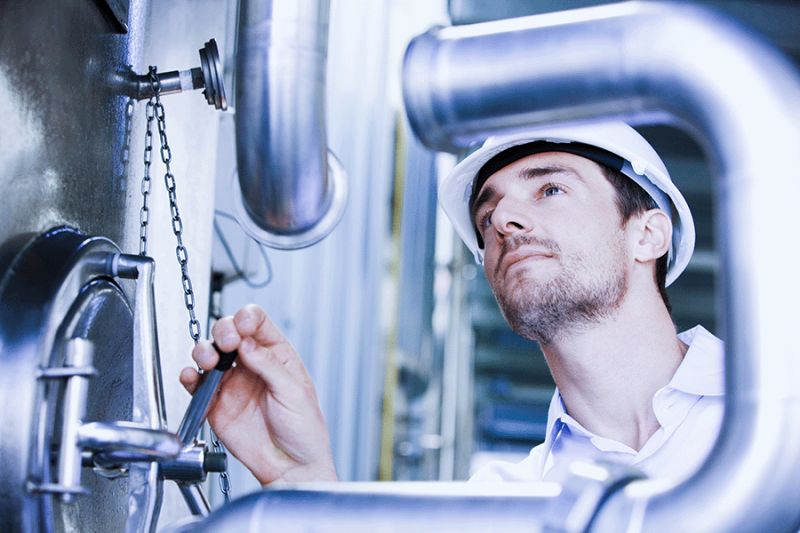
Effective and Self-Driven Anticipation
In a changing operating environment, the ability to see around the corner is a prerequisite for success. Responsible Care helps companies, among other things, develop their skills in anticipation and preparedness, as well as measure the complex safety environment. This fosters the capability to develop processes and products that are more sustainable and safer.
Developing safety and well-being has yielded long-term results in the chemical industry. Safety in production also includes process safety.
Safety expertise is a vital part of the competence of the personnel in the chemical industry. Companies participating in the Responsible Care sustainability program in the chemical industry organize nearly 3,000 training sessions on environmental, health, and safety topics annually. Chemical Industry Finland collaborates with the Safety Technology Advisory Board and the Safety and Chemicals Agency (Tukes) on matters related to safety expertise.
Product responsibility means safe products for the chemical industry, responsible supply chains, and manufacturing processes that are sustainable in terms of health, the environment, and social responsibility. The safety of products must be objectively assessed throughout their entire lifecycle, from raw materials to production, consumption, recyclability, or disposal.
The REACH regulation and the CLP regulation concerning the classification, labeling, and packaging of chemicals set high requirements for determining the properties of chemicals and ensuring their safe use. In addition, various product-specific regulations impose various information and composition requirements for the product. All key product regulations are EU regulations that enable the free movement of chemicals within the Union. The chemical industry, in collaboration with authorities, seeks to ensure that regulations are implemented fairly for companies and that their further development is based on scientific knowledge.
Key regulations in product legislation include:
- The CLP Regulation for the classification, labeling, and packaging of substances and mixtures.
- The REACH Regulation for the registration, evaluation, authorization, and restriction of chemicals.
- The Biocidal Products Regulation for the pre-approval of biocidal products.
- The Plant Protection Products Regulation for the pre-approval of plant protection products.
Work and activities that cannot be conducted without causing harm to people, the environment, and property should not be carried out. This is why safety is a prerequisite for the existence of the chemical industry in Finland. Chemical industry substances and equipment involve hazards that result in the risk of accidents. Risk management is, therefore, a crucial part of all chemical industry operations.
Accidents can be avoided by ensuring that:
- The equipment used is suitable for its purpose and in good condition.
- Employees handling equipment and chemicals are skilled professionals who can perform tasks correctly and safely.
- Risks are anticipated, and measures are in place to mitigate them. Risks should be identified, and in cases where the risk of an accident is high and/or the potential consequences of an accident are significant, multiple mechanical safeguards should be in place to halt the chain of events leading to an accident. These safeguards may include safety automation and relief valves.
- Competent personnel can identify hazardous situations and know how to respond correctly.
Safety covers various aspects of a company’s operations, and to manage it more effectively, it is divided into the following areas:
- Occupational Safety: The safety of individuals is always the highest priority. Employees must be trained to carry out their tasks, be aware of workplace hazards and risks, and take measures to protect themselves. Additionally, work should be instructed and managed in a way that ensures it is done safely.
- Process Safety: Equipment and systems must be in good condition and used and maintained appropriately. Monitoring the condition of equipment is a crucial part of the chemical industry. Modifications to equipment should be carried out in a controlled manner with a full understanding of the associated risks.
- Environmental Safety: Substances that do not belong in the environment should not be released into it. A company’s environmental permit sets the boundaries for production activities.
- Transport Safety: Chemicals are in close proximity to people and the environment during transportation, making transportation safety a particular concern. Laws governing the transportation of hazardous substances, along with international regulations, regulate the transportation of chemicals.
- Physical Security (Security): Because the chemical industry is a significant industrial sector in society, and because chemicals are often hazardous substances, there is a risk that unauthorized individuals may attempt to steal chemicals or cause other harm to businesses. Therefore, companies must ensure that unauthorized individuals cannot access chemicals or production facilities.
- Cybersecurity: Companies’ information systems and certain significant equipment are connected to the internet. This can provide an avenue for criminals to breach a company’s systems. Therefore, companies must ensure that these connections are well-protected.

The accident frequency rate within the chemical industry is significantly lower than the industrial average in Finland
Since the year 2000, accidents leading to absence have decreased by one-fourth. The continuously increasing number of safety observations and documented near-miss incidents also attests to our active safety mindset.
Product Safety
Chemistry is an enabling discipline that allows for the modification of substances and the development of applications that enhance well-being. The safety of products resulting from innovation must be objectively assessed throughout their entire lifecycle, from raw materials to manufacturing, consumption, recyclability, and disposal.
Product responsibility in the chemical industry encompasses the provision of safe products, responsible supply chains, and manufacturing processes that are sustainable in terms of health, environment, and social responsibility. The safety of products resulting from innovation must be objectively evaluated throughout their lifecycle, from raw materials to manufacturing, consumption, recyclability, or disposal.
The REACH Regulation and the Classification, Labelling, and Packaging (CLP) Regulation pertaining to chemicals set high requirements for understanding chemical properties and ensuring their safe use. Additionally, numerous product-specific regulations impose various disclosure obligations and composition prerequisites. All key product regulations are supranational EU regulations, enabling the free movement of chemicals within the EU territory. In collaboration with authorities, the chemical industry strives to ensure the equitable implementation of regulations for companies and their further development based on scientific knowledge.
Key Provisions of Product Legislation
- The CLP Regulation for the classification, labelling, and packaging of substances and mixtures
- The REACH Regulation for the registration, evaluation, authorization, and restriction of chemicals
- The Biocidal Products Regulation for the pre-approval of biocidal agents
- The Plant Protection Products Regulation for the pre-approval of pesticides
Chemical safety refers to the safe and appropriate use of products. It is essential for users of chemical industry products, including both industrial professionals and consumers, to familiarize themselves with the product usage instructions and adhere to them.
Due to the comprehensive and stringent chemical regulations in the EU, as well as companies’ product responsibility programs, there is a wealth of information available about chemical substances. Ensuring their safety and providing guidelines for their safe use is a prerequisite for their presence in the market. Legislation has established a minimum level that guarantees the safety of products on the market, and authorities oversee the entire manufacturing and distribution chain to ensure compliance with these requirements within the EU. The components of chemical products have been tested for health and environmentally significant properties. If precautionary measures are necessary based on the results, instructions are provided on the product packaging.
When it comes to chemicals, consumers do not need to perform risk assessments in stores; products that neglect safety aspects are not allowed on the market. However, all chemicals must be stored out of the reach of children in households. Chemicals should also be kept in their original packaging, which includes instructions for use and safety. They should not be transferred to other containers, such as soft drink bottles, for space-saving reasons. While innovation is encouraged in business, consumers should refrain from seeking new applications for household chemicals. Chemicals should be used only in accordance with the manufacturer’s instructions.
Chemical safety is a shared goal among the chemical industry, authorities, and consumers.
Measuring Responsibility in the Chemical Industry
The chemical industry’s Responsible Care sustainability program has been in operation in Finland for over 30 years. Companies committed to the program provide annual reports on the sustainability and safety of their production and products. In this way, we obtain meticulously measurable data on the safety progress within the chemical industry.

